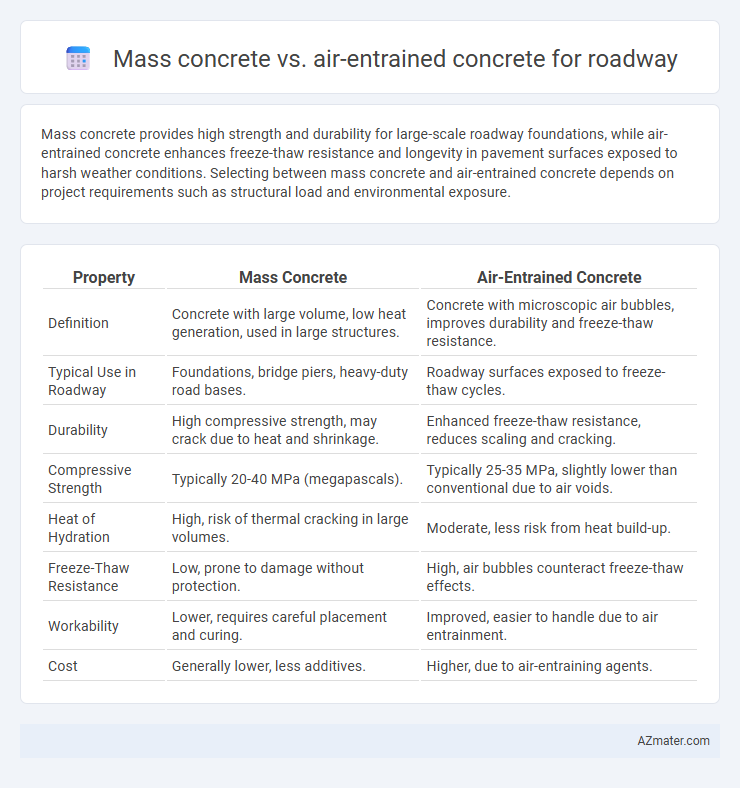Mass concrete provides high strength and durability for large-scale roadway foundations, while air-entrained concrete enhances freeze-thaw resistance and longevity in pavement surfaces exposed to harsh weather conditions. Selecting between mass concrete and air-entrained concrete depends on project requirements such as structural load and environmental exposure.
Table of Comparison
| Property | Mass Concrete | Air-Entrained Concrete |
|---|---|---|
| Definition | Concrete with large volume, low heat generation, used in large structures. | Concrete with microscopic air bubbles, improves durability and freeze-thaw resistance. |
| Typical Use in Roadway | Foundations, bridge piers, heavy-duty road bases. | Roadway surfaces exposed to freeze-thaw cycles. |
| Durability | High compressive strength, may crack due to heat and shrinkage. | Enhanced freeze-thaw resistance, reduces scaling and cracking. |
| Compressive Strength | Typically 20-40 MPa (megapascals). | Typically 25-35 MPa, slightly lower than conventional due to air voids. |
| Heat of Hydration | High, risk of thermal cracking in large volumes. | Moderate, less risk from heat build-up. |
| Freeze-Thaw Resistance | Low, prone to damage without protection. | High, air bubbles counteract freeze-thaw effects. |
| Workability | Lower, requires careful placement and curing. | Improved, easier to handle due to air entrainment. |
| Cost | Generally lower, less additives. | Higher, due to air-entraining agents. |
Understanding Mass Concrete and Air-Entrained Concrete
Mass concrete, characterized by its large volume and low heat dissipation rate, is designed to minimize thermal cracking by controlling temperature gradients during curing in roadway applications. Air-entrained concrete contains microscopic air bubbles that enhance freeze-thaw durability and improve resistance to scaling caused by deicing chemicals, making it ideal for roads exposed to harsh climates. Understanding the distinct benefits of mass concrete's thermal management and air-entrained concrete's durability is crucial for selecting the appropriate mix for long-lasting roadway infrastructure.
Composition Differences in Mass vs Air-Entrained Concrete
Mass concrete for roadways features a dense mix with low water-cement ratios and minimal air content, maximizing strength and durability in large pours. Air-entrained concrete incorporates microscopic air bubbles through air-entraining agents, enhancing freeze-thaw resistance and reducing surface scaling in cold climates. The main compositional difference lies in the deliberate introduction of air voids in air-entrained concrete, which is absent in mass concrete formulations designed for high structural integrity.
Thermal Behavior: Mass Concrete vs Air-Entrained Concrete
Mass concrete exhibits slower heat dissipation due to its large volume, leading to higher internal temperatures and increased risk of thermal cracking during hydration. Air-entrained concrete incorporates microscopic air bubbles that improve thermal insulation and reduce the rate of temperature rise, enhancing freeze-thaw durability in roadways. Effective thermal management in mass concrete reduces shrinkage stresses, while air-entrained concrete provides better resistance to thermal fluctuations caused by environmental exposure.
Durability and Longevity in Roadway Applications
Mass concrete exhibits high durability in roadway applications due to its low permeability and resistance to freeze-thaw cycles, which minimizes cracking and extends pavement lifespan. Air-entrained concrete enhances longevity by incorporating microscopic air bubbles that improve resistance to frost damage and deicing chemicals, making it ideal for harsh climates. Selecting the appropriate concrete type depends on environmental exposure and load conditions, ensuring optimum performance and reduced maintenance costs.
Workability and Placement Challenges
Mass concrete used in roadway construction often faces workability challenges due to its low water-to-cement ratio and high volume, leading to difficulties in proper compaction and placement. Air-entrained concrete improves workability by incorporating microscopic air bubbles, which enhance freeze-thaw resistance and reduce segregation, but requires careful control during mixing to maintain consistent air content. Proper placement of mass concrete demands meticulous temperature control and vibration techniques, whereas air-entrained concrete benefits from improved flowability but necessitates monitoring to prevent excessive air voids that can weaken structural integrity.
Freeze-Thaw Resistance: Performance Comparison
Mass concrete exhibits lower freeze-thaw resistance due to its dense, low-porosity structure, making it more susceptible to cracking under cyclic freezing and thawing conditions in roadway applications. Air-entrained concrete significantly enhances freeze-thaw durability by incorporating microscopic air bubbles that serve as pressure relief sites, reducing internal stress and preventing surface scaling. Studies indicate that air-entrained concrete can improve roadway lifespan by up to 50% in freeze-thaw environments compared to non-air-entrained mass concrete.
Cost Implications for Roadway Construction
Mass concrete generally incurs higher initial costs due to the need for specialized formwork, extensive curing methods, and temperature control measures to prevent cracking. Air-entrained concrete offers cost savings by enhancing durability and reducing maintenance expenses, minimizing freeze-thaw damage and surface scaling in roadway applications. Evaluating life-cycle costs reveals air-entrained concrete as more economical for cold climates, while mass concrete may be justified for large structural road components requiring high strength.
Sustainability and Environmental Impact
Mass concrete offers excellent durability and thermal stability for roadways but often requires substantial cement content, increasing carbon emissions and environmental footprint. Air-entrained concrete enhances freeze-thaw resistance and reduces permeability, improving longevity and reducing maintenance-related environmental costs. Utilizing supplementary cementitious materials in both types can optimize sustainability by lowering greenhouse gas emissions while maintaining structural performance.
Common Use Cases in Roadway Projects
Mass concrete is commonly used in roadway projects for heavy-duty structures such as bridge abutments, retaining walls, and dam foundations due to its ability to minimize thermal cracking through controlled heat generation. Air-entrained concrete is favored for pavements, sidewalks, and highway shoulders where freeze-thaw durability and resistance to deicing chemicals are critical for longevity and safety. Combining mass concrete properties with air-entrainment techniques can enhance durability in harsh climates but is typically deployed in layered roadway designs for optimal performance.
Selecting the Right Concrete Type for Roadway Needs
Mass concrete offers superior durability and thermal control for large roadway structures, effectively minimizing thermal cracking during curing. Air-entrained concrete enhances freeze-thaw resistance, making it ideal for roadways exposed to harsh weather and deicing salts. Selecting the right concrete type depends on factors like environmental conditions, structural requirements, and maintenance considerations for optimal roadway performance.

Infographic: Mass concrete vs Air-entrained concrete for Roadway
 azmater.com
azmater.com